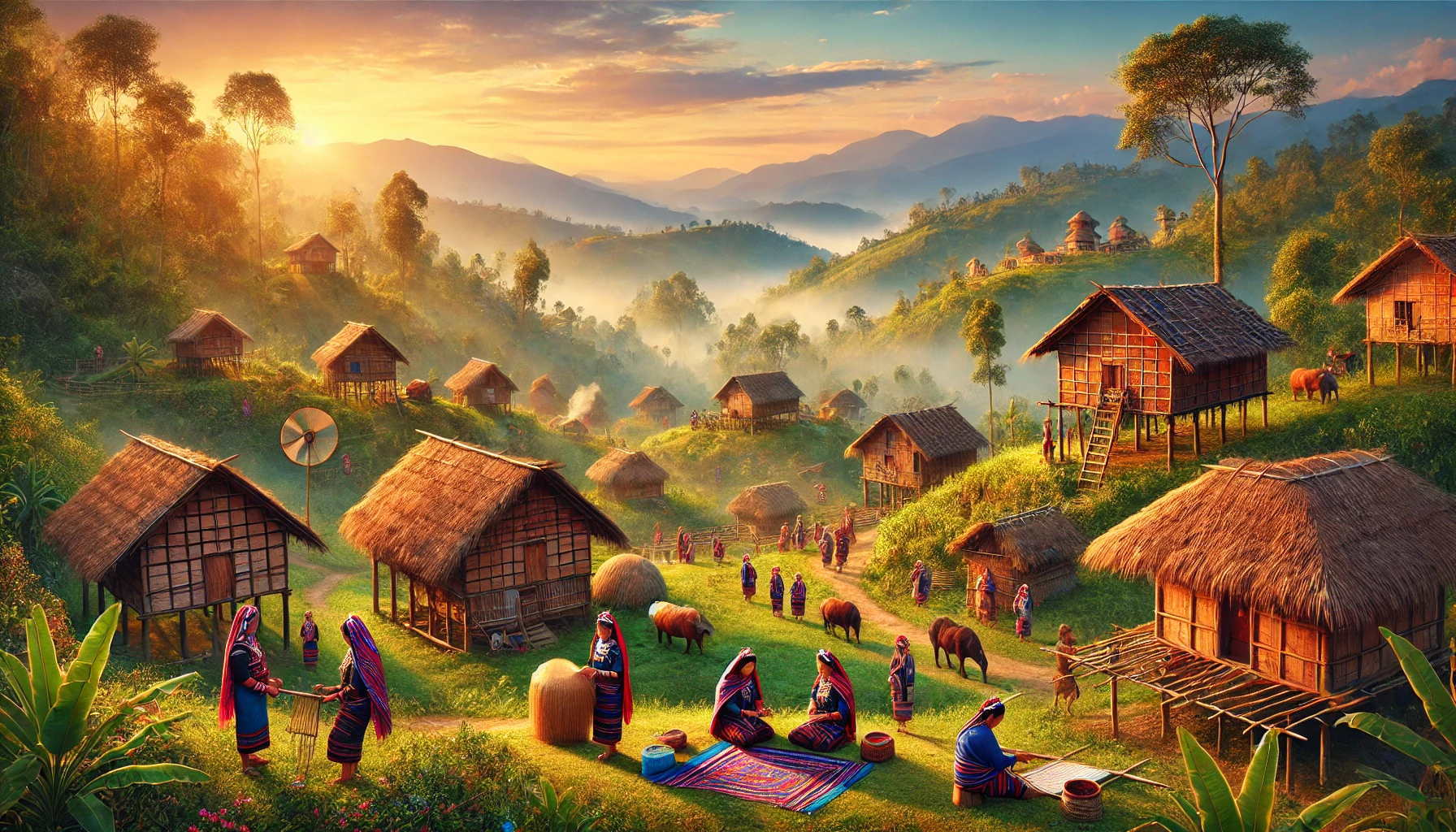
Nagaland, a vibrant and picturesque state located in the northeastern part of India, is a land steeped in rich traditions, colorful festivals, and deep-rooted tribal culture. The state is home to sixteen major tribes, each with its own distinct identity, language, and customs, making it one of the most culturally diverse regions in India. Despite the state’s small size and geographical isolation, Nagaland has preserved its unique heritage through centuries of history. In this article, we delve into the traditions, lifestyle, and cultural significance of Nagaland, offering you a glimpse into the life of its people.
The History and Origins of Nagaland’s Tribes
Nagaland’s historical narrative is deeply intertwined with its indigenous tribes, who have lived in the hills of this region for centuries. The majority of the population in Nagaland belongs to the Naga ethnic group, a term used to collectively refer to multiple tribes such as the Angami, Ao, Sumi, Lotha, and many others. Each tribe has its own origin story, mythology, and distinct way of life, contributing to the state’s rich cultural tapestry.
The early history of Nagaland is marked by the migration of tribes from Southeast Asia and surrounding regions. These tribes established themselves in the hilly terrain, forming small autonomous communities that were largely independent. Despite the geographic isolation, the tribes maintained vibrant social structures, where their culture, governance, and traditions flourished. Their way of life was often influenced by the region’s rugged environment, fostering a deep connection between the people and their land.
Colonial contact brought significant changes to the region, particularly with the advent of British rule in the 19th century. Despite outside influence, the tribes of Nagaland managed to preserve their cultural identity, a testament to the resilience and strength of their traditions. Today, the tribes of Nagaland continue to celebrate their history and heritage through a variety of festivals, rituals, and customs that have been passed down through generations.
Traditional Festivals and Celebrations
Festivals form an integral part of the traditional life in Nagaland, with each tribe hosting their own unique celebrations throughout the year. These festivals are often tied to agricultural cycles, religious beliefs, and historical events, making them a vital aspect of the local culture. One of the most famous festivals in the region is the Hornbill Festival, which is celebrated annually in December. Known as the “Festival of Festivals,” the Hornbill Festival brings together all the tribes of Nagaland to showcase their cultural heritage through music, dance, and art.
The Hornbill Festival is named after the great Indian hornbill, a bird deeply revered in Naga culture. The festival is held in Kisama, a village near Kohima, and is a week-long celebration that features traditional music, folk dances, indigenous games, and handicrafts. It provides a unique platform for the tribes to display their rich heritage, attracting visitors from all over the world.
Another important festival in Nagaland is the Sekrenyi Festival, celebrated by the Angami tribe. It marks the beginning of the new year and is closely associated with purification rituals. The festival involves various ceremonies, including a community feast, folk songs, and dances. The Ao tribe celebrates Moatsu, a festival of merrymaking, which includes community bonding activities such as building friendships and offering sacrifices for a prosperous harvest. Each tribe’s festivals are unique, yet they all reflect the core values of unity, gratitude, and respect for nature that define Naga society.
Traditional Clothing and Handicrafts of Nagaland
The traditional attire of the Naga people is a reflection of their tribal identity, cultural pride, and craftsmanship. Each tribe in Nagaland has its own distinct clothing style, characterized by vibrant colors, intricate patterns, and handcrafted textiles. The most iconic element of Naga attire is the shawl, which is not just a garment but a symbol of status and identity. Different tribes have specific designs and colors associated with their shawls, often indicating the wearer’s social status, achievements, and tribe.
For instance, the Ao tribe’s warrior shawl, known as “Tsüngkotepsü,” features elaborate motifs representing valor and honor in battle. The Sumi tribe’s “Akhüm” shawl, on the other hand, has bold patterns that denote the wearer’s bravery and accomplishments in the community. These shawls are woven by the women of the tribe, who pass down the art of weaving from one generation to another. The process of making these textiles is meticulous, with natural dyes often being used to create the vibrant hues.
In addition to textiles, Nagaland is also known for its exquisite handicrafts. Wood carving, basket weaving, pottery, and beadwork are some of the traditional crafts practiced by the Naga people. The craftsmanship is not only utilitarian but also holds deep cultural significance, often reflecting aspects of tribal folklore, mythology, and spirituality. For example, carved wooden totems and ceremonial masks are frequently used in rituals and are believed to possess protective powers. These traditional crafts are not just a means of livelihood for the artisans but also a way to preserve and transmit cultural knowledge across generations.
The Unique Architecture and Village Life in Nagaland
Village life in Nagaland is deeply rooted in tradition, with a strong sense of community and self-sufficiency. The Naga villages are often situated on hilltops, surrounded by lush greenery and offering breathtaking views of the surrounding valleys. The layout of a typical Naga village reflects the tribe’s social hierarchy, with the village chief’s house usually occupying the highest point, symbolizing his leadership and authority.
Naga houses are traditionally built using locally sourced materials such as bamboo, wood, and thatch. The architecture of these houses is simple yet functional, designed to withstand the region’s heavy rainfall and mountainous terrain. A distinctive feature of Naga homes is the presence of a “morung,” a large communal dormitory for young men. The morung serves as a place of learning where young boys are taught the tribe’s traditions, hunting skills, and social responsibilities. It is also a space for storytelling, music, and dance, fostering a strong sense of community among the youth.
Life in the villages revolves around agriculture, with most families engaged in farming as their primary occupation. The Naga people practice shifting cultivation, also known as “jhum” farming, which involves clearing a patch of forest for cultivation and then leaving it fallow for a few years to allow the land to regenerate. This sustainable method of farming reflects the Naga people’s deep respect for nature and their symbiotic relationship with the environment.
The social fabric of Naga villages is closely knit, with strong communal ties and mutual support. Traditional governance structures, led by village councils and elders, play a crucial role in maintaining peace and resolving disputes. These councils uphold customary laws that have been passed down through generations, ensuring that the tribe’s way of life is preserved. Despite modernization, many Naga villages continue to adhere to these age-old systems of governance, balancing tradition with contemporary realities.
Naga Cuisine: A Culinary Journey Through the Hills
Naga cuisine is a reflection of the state’s natural bounty and its people’s connection to the land. The food of Nagaland is known for its simplicity, yet it is packed with bold and unique flavors. Ingredients are often sourced from the forests and fields, with rice being the staple food for most tribes. The Naga people have a deep respect for their ingredients, and this is reflected in the way they prepare their meals—minimally processed, yet deeply flavorful.
One of the defining features of Naga cuisine is its love for smoked meats. Pork is a popular choice, often smoked over open flames to develop a rich, smoky flavor. This method of preserving meat not only enhances its taste but also allows it to be stored for longer periods. Dishes like “smoked pork with bamboo shoots” are a staple in Naga kitchens, combining the smoky richness of pork with the earthy, tangy flavor of bamboo shoots.
Naga cuisine is also known for its use of fiery spices, particularly the Bhut Jolokia, one of the world’s hottest chili peppers, which is indigenous to the region. This chili, along with fermented ingredients like bamboo shoots, beans, and fish, adds a distinctive kick to the dishes. “Axone,” a fermented soybean paste, is another key ingredient that imparts a pungent, savory flavor to many Naga dishes. It is commonly used in stews, curries, and chutneys, giving the food its characteristic bold taste.
In addition to its rich meat-based dishes, Naga cuisine includes a wide variety of greens and foraged vegetables, such as ferns, wild mushrooms, and herbs. These are often stir-fried or steamed, maintaining their natural flavors and nutritional value. Meals are typically accompanied by side dishes like “roja,” a spicy Naga chutney, and “galho,” a rice-based porridge flavored with seasonal vegetables and meat. Through their culinary traditions, the Naga people showcase their deep connection to the land and their ability to create wholesome, flavorful dishes using locally available ingredients.
Preserving the Cultural Heritage of Nagaland
Despite the challenges of modernization and globalization, the people of Nagaland remain deeply connected to their traditions and culture. Various efforts are being made to preserve and promote the rich cultural heritage of the state, ensuring that future generations can continue to celebrate their unique identity. The Hornbill Festival, for instance, has become a major cultural event that not only brings together the Naga tribes but also helps promote their culture to the outside world.
In addition to festivals, cultural preservation is also evident in the revival of traditional art forms and crafts. Local artisans are encouraged to continue practicing age-old crafts such as weaving, wood carving, and pottery, while younger generations are being taught these skills through workshops and community initiatives. These efforts are crucial in preserving the intangible cultural heritage of Nagaland, ensuring that traditional knowledge is passed down from one generation to the next.
Education and awareness programs also play a significant role in preserving Nagaland’s heritage. Schools and institutions are incorporating local history, language, and culture into their curricula, fostering a sense of pride among the youth for their Naga identity. In recent years, there has also been an increased focus on documenting and recording oral histories, folk tales, and traditional music, ensuring that these valuable cultural assets are not lost to time.
As Nagaland continues to evolve and develop, its people remain resilient in their efforts to uphold the cultural values that have defined their way of life for centuries. Through their strong sense of community, respect for tradition, and commitment to preserving their heritage, the Naga people are ensuring that their unique culture continues to thrive in the modern world.








